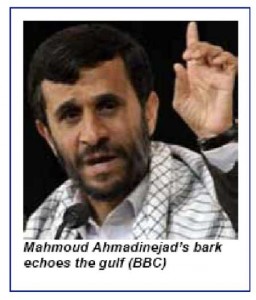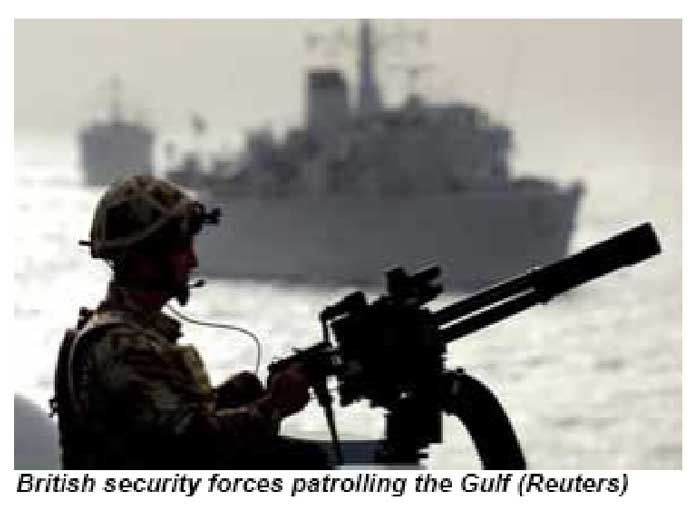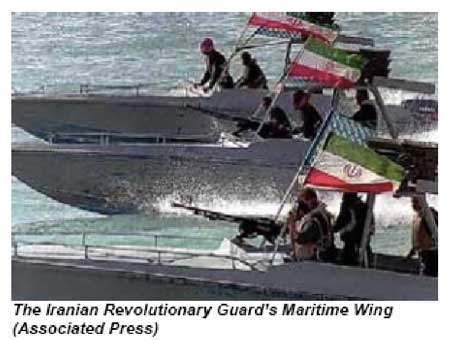By Dr. Heinrich Matthee, Academic Head, Black Hall College London
Dr. Heinrich Matthee is a political and security risk analyst specializing on the Middle East and Muslim politics worldwide. Dr. Matthee has more than 14 years’ experience of advising governments, multinational companies and NGOs.
10/08/2010 – This article was originally posted in Strategic Insights, Number 24 (June 2010), published by Risk Intelligence.
Credit: Iranian Navy Operations, US Navy
Iran’s leadership has been under severe pressure during the past twelve months. Infighting among the political elite and persistent popular protests since the presidential elections of 12 June 2009 are still fuelling tensions. Outside Iran, the US has increased pressure, with US Secretary of State Hillary Clinton even raising the prospect of ‘crippling sanctions’.
What will the likely responses of Iran’s rulers be? Under what conditions would maritime actions become likely? Would they include a closure of the Strait of Hormuz, through which 40% of the world’s tradable oil flows?
Political turmoil
The protests against perceived manipulation of the election results in June 2009 at times involved an estimated hundred thousand demonstrators in the streets of central Tehran. Some Western media speculated that it was a Green Revolution that would sweep the current regime from power.
However, within ten days the government effectively stopped the protests from completely spiraling out of its control. While CNN was still broadcasting the same images of massive street demonstrations by late June, demonstrations were by then much smaller and limited to a few places in the big city of more than 8 million people.
The protests have recurred on Quds day on 18 September and the 13th of Aban on 4 November 2009. During Student Day and the Ashura festival in December protests occurred in several cities, including Esfahan, Tabriz and Mashhad. Protests also occurred on the anniversary of the Islamic Revolution in February 2010.
The protests have by now changed into protests against parts of the Islamic system itself, reflecting a weaker legitimacy of the regime among parts of the Iranian electorate. However, the size of demonstrations has declined. While the government is less popular or accepted than before, the protesters have demonstrated that they simply do not have the ability to overthrow the government.
Credit table: Strategic Insights
Among the factors that have resulted in this outcome are the impact of targeted suppressive measures, the exertion of the Supreme Leader’s authority and no split in the security forces. The lack of an armed underground movement, and the absence of a strong unified leadership and communication system among the protesters in disparate regions have also played a role.
Thus, even if the protest campaign cannot be crushed, it can at present be contained. Still, the outpouring of dissent has weakened the sense of control of the government. The political turmoil has amplified the divisions between and among different powerful elite factions. This state of affairs and a sense of being under siege are likely to influence policy responses to foreign pressure.
A Tough Government
The government itself may have a weaker hold on power than a year ago, but it can by no means be described as a pushover. In fact, it is dominated by tough pragmatists like the Supreme Leader Ali Khamenei, the highest political authority, and policy hardliners around him, including president Mahmoud Ahmadinejad.

Khamenei has increasingly relied on the Islamic Revolutionary Guards Corps or Pasdaran, the elite para-military group of about 125,000 members established to protect the revolutionary project in 1979 and the most loyal part of the government apparatus.
Even before Ahmadinejad came to power in 2005, the Supreme Leader had started reorganizing. Khamenei’s aim in this regard had been and has been to increase the resilience of the regime against foreign pressure and to expand the domestic reach of loyalists. His approach was influenced and supported by the appearance of a new generation among the political and military leadership, those who had been the foot soldiers of the Islamic revolution and the front soldiers of the Iran-Iraq war.
The power of the Pasdaran has expanded in the security domain, but also in politics and the economy. Khamenei will continue to rely on it as a mainstay of power during the current period of political turmoil.
Iran’s decision-makers will also remain under pressure from peers and intra-elite competitors not to appear ‘soft’ on issues threatening the Islamic system. Both structural and situational factors will therefore result in a preference for robust responses to both domestic and foreign pressure.
The Pasdaran, which also oversees Iran’s nuclear and missile programs, are likely to play an important role in such responses.
Geopolitical Competition
Since 1979, strategic competition has dominated relations between Iran on the one hand and the US, other Western powers and Israel on the other. For the time being, this strategic competition will continue. The Iranian leadership will continue trying to improve its existing political options or to create new ones. One means has been to build its military capability. This capability allows it to expand its influence and project its power against targets in Western Asia, the Gulf and the GCC states. It also serves to create or reinforce deterrence and intimidation. In addition, it limits or denies the military options of competing states.
In this regard, there are close links between several Iranian projects. The first is the upgrading of the military forces, seen for example in the launch of the first locally-developed destroyer, the Jamaran, at a ceremony attended by the Supreme Leader on February 2010. Other projects include its missile programs, its probable chemical and biological weapons capability and its nuclear program, which probably aims at the development of a civilian nuclear capability that could be weaponized at short notice. Iran’s emphasis on asymmetric warfare and its approach to maritime security should also be viewed in this context.
Iran’s Maritime Security in the Arabian Peninsular/Gulf
Maritime security forms an important part of Iran’s strategic position. The 600-mile-long Persian/Arabian Gulf is one of the most important waterways in the world. Almost 40% of the world’s traded oil is normally being shipped through the Gulf and the Strait of Hormuz.
The key passages through the Strait consist of 2- mile wide channels for inbound and outbound tanker traffic. Tanker and shipping routes pass close to Iran’s land mass, its naval bases and the islands it controls in the Gulf. This situation creates vulnerabilities for Iran.
In addition, Iran has been involved in territorial disputes with its United Arab Emirates neighbors over ownership of three islands near key tanker routes, namely Abu Musa, Greater Tunb Island and Lesser Tunb Island. Both Iran and Qatar have also claimed ownership of the North field, the site of most of Qatar’s gas reserves.
However, Iran is also conscious of its ability to put pressure on strategic competitors like the US in the Gulf. In a speech in June 2006, Supreme Leader Khamenei stated that if any country attacked Iran, “shipment of energy from this region will be severely jeopardized.”
Naval Abilities
Iran has two naval forces to pursue its interests in the Gulf, namely the regular navy and the Pasdaran navy. The main bases of the regular navy include Bandar e-Abbas, Bushehr and Kharg Island. The regular navy operates traditional warships and auxiliary ships.
However, the regular navy is smaller than the Pasdaran navy. During the past few years it has often lost to the Pasdaran navy in the competition for bureaucratic resources. The Pasdaran has a 20,000 man naval branch with facilities at Bandar-e-Abbas, Khorramshar and the Halul oil platform. It also has facilities on the islands of Larak, Abu Musa, Al Farsiyah and Sirrir and uses the main naval bases. In addition, the Pasdaran controls access to smaller jetties, which are also used to evade sanctions and smuggle commodities without paying the required customs.
In 2007, the Pasdaran navy was given full operational control of the Gulf, while the regular navy was assigned to the Gulf of Oman and the Caspian Sea. The Pasdaran navy has focused on obtaining small, fast boats. Some of these boats are armed with recoilless rifles and rocket launchers, others with man portable surface-to-air missiles and anti-armor guided weapons.
Iran can target any point within the Strait of Hormuz and much of the Persian Gulf and Gulf of Oman with C-802 anti-ship missiles bought from China.
In past years, both the navy and the regular navy have increased their mine-laying capability. The Strait of Hormuz could be mined in a relatively short amount of time. Lacking modern mine-laying vessels, the naval forces could deploy mines using commercial vessels and small boats.
Asymmetric Warfare
Iran’s security force doctrines compensates for the limits to their capabilities. In general, Iran’s deployments and maritime strategy reflect a defensive approach that focuses on deterrence and attrition. Since the Iran-Iraq tanker war during 1984-1988, maritime strategy has also incorporated asymmetric warfare.
Asymmetric warfare emphasizes the use of small assets’ strengths, for example the stealth, maneuverability and speed of small boats, against the weaknesses of big opponents, such as sluggish ships. An emphasis on a “revolutionary” resilience and a commitment to Islamic martyrdom also complement this doctrine.
Other elements of Iran’s maritime strategy have been a passive defense to survive a first strike through camouflage, deception and tunnels and bunkers. A decentralized command system to increase its resilience has also been developed.
Another element has been to capitalize on favorable geography, for example the shallow waters, coves and marshes on the coastline, and narrow lanes of the Gulf.
At present, it seems unlikely that the US would launch an attack on Iran’s nuclear facilities. However, if the current tensions between Iran and the US or Israel would escalate into a war or a strike on Iran’s nuclear facilities, Iran would seriously consider forms of asymmetric warfare in the Gulf. These could also assume the form of low-level and deniable measures, like the selective and periodic use of mines.
Strategic Messaging and Naval Diplomacy
The maritime dimension has historically been used by Iran to advance its geopolitical aims. Iranian naval forces have in the past used several forms of peacetime gunboat diplomacy. In 1971, during the rule of the Shah, they also created a fait accompli by occupying Abu Musa Island.
Iran’s navy has in the past year stepped up activities aimed at countering piracy. In April and May, Iranian naval ships warded off attacks in the Gulf of Aden by pirates against Iranian ships transporting goods and oil. As reflected in the statements of Iranian delegates to the Indian Ocean Naval Symposium in Abu Dhabi in mid-May 2010, Iran also uses the situation of limited international success against piracy in the region to support its case for a regional security arrangement that would exclude Western powers.
Fiften British Royal Marines taken by the Pasdaran navy in March 2007 occurred at a time when Iran was under increased pressure about its nuclear program and shortly after US forces had raided an Iranian diplomatic office in Arbil, Iraq, in the hope of capturing two senior Iranian officials. Whether intended or not, the naval incident bought some breathing space for Iran at the time as far as the US and UK campaign against its nuclear program was concerned.
The Pasdaran and regular navy also regularly conduct naval/air exercises in the Gulf. During the exercises, they usually train and demonstrate their ability to attack ships, offshore oil fields and coastal desalination and power facilities, also through naval commando operations.
These exercises are often timed to precede UN sessions, important international meetings on Iran’s nuclear program or further sanctions, or key US decisions on Iran. As during the latest exercise in the Strait of Hormuz and northern Indian Ocean, which lasted eight days and ended on 12 May 2010, deterrence has been a major objective of the event.

Different naval actions have been employed to deter or influence Western powers. The seizure of Iranian psychological warfare in the Gulf: Iran’s rulers have several options if they want to exert pressure on the US or send a strategic message: funding, training and arming of Hizbollah, Hamas and some insurgent groups in Iraq and Afghanistan, as well as the support of some pressure groups in Gulf Arab states.
However, the withdrawal of most US troops from Iraq by mid-2010 will reduce the possibility to exert pressure by threatening measures against US soldiers there.
This situation, in conjunction with increased foreign pressure, domestic political turmoil, and hardline government elements considering themselves under siege, could result in Iran’s security forces considering the Gulf more often as a theatre to exert pressure. Periodic incidents like the capture of the British Royal Marines in 2007 or the capture of British servicemen in 2004 in the Shatt al-Arab waterway where they were training the Iraqi river patrol service will therefore remain a likely occurrence.
Non-military vessels will mostly be at lower risk, but their owners should prepare for higher incidental risk and design contingency plans in case such an incident has an impact on business operations.
However, closure of the Strait of Hormuz during a period of tensions or even armed hostilities is much less likely. Due to foreign sanctions and domestic mismanagement Iran’s economy has become extremely dependent on a few refineries, product imports and food imports. It could not choke off the Strait of Hormuz for more than a few days, even if it was willing to sacrifice all its assets.
Still, this state of affairs does not preclude the use of threats in peacetime about blocking the Strait or interfering with free shipping in the Strait. The threat of action in the Gulf and the Strait of Hormuz and resulting high insurance premiums and oil prices will continue to constitute one of the more cost-effective ways for Iran to respond to extreme US pressure.
Gulf oil production and the importance of Gulf exports as a percentage of total world exports are also expected to increase in the next decade. The Gulf is likely to remain a prime potential theatre for Iranian measures to limit or deter foreign intervention.



